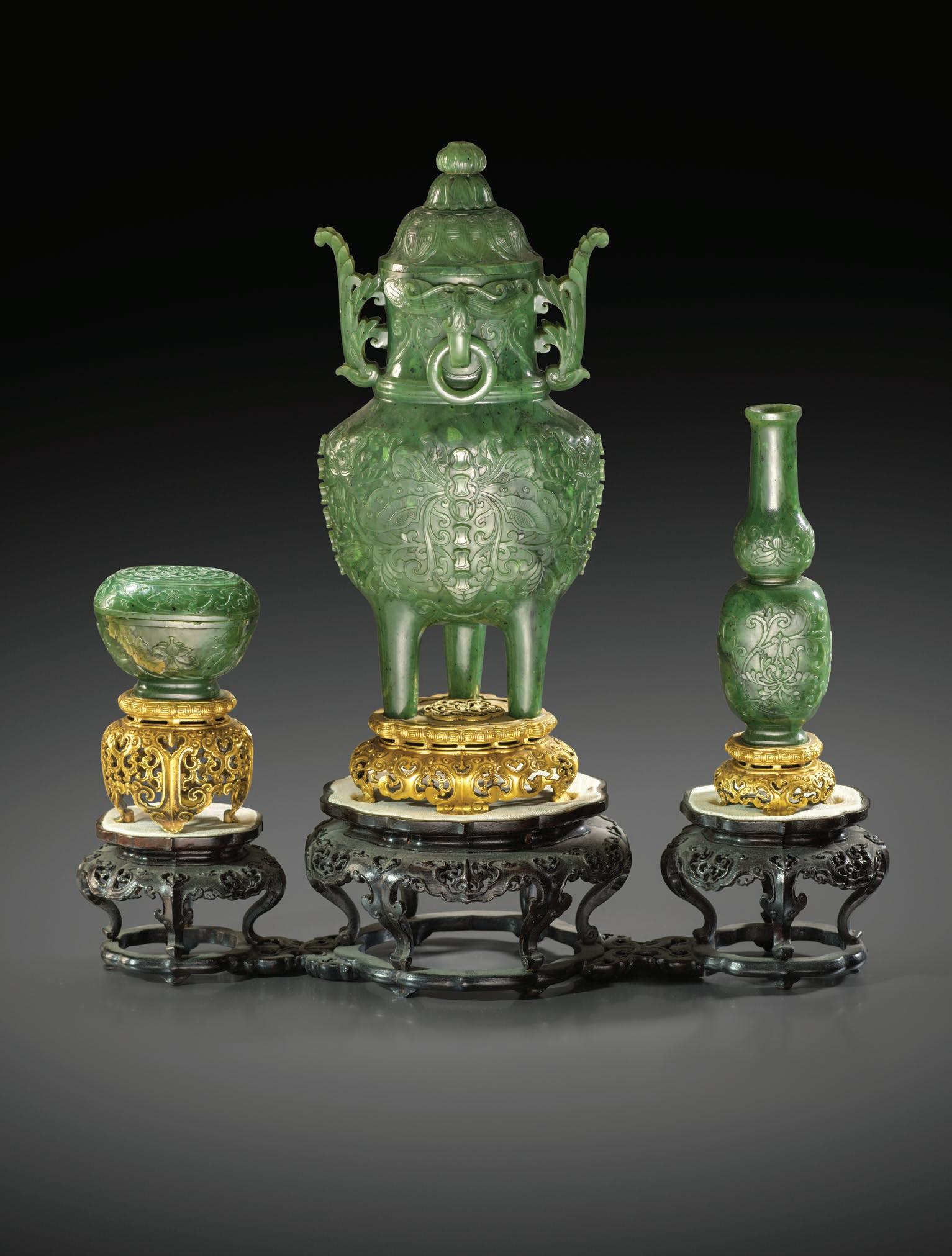
4 minute read
FINE ASIAN ART
The Lawrence Jade Collection
The fabulous jades acquired by Neville and Murray Lawrence include a pair of superb dragon seals from the collection of Major-General Charles Gordon; a massive incense burner from Sir John Buchanan-Jardine Bt; several items from the collection of Hugh Sartorius Whitaker, as well as the exceptional white jade Imperial jars and covers which are illustrated here, from the collection of HM Queen Maria of Yugoslavia. Neville purchased twenty-six of these treasures from Spink & Son prior to 1959, the remaining eight were bought by Murray from Roger Keverne in the 1990s and early 2000s.
Advertisement
Left:
A set of three fine Chinese spinach-green jade altar vessels, Qianlong 1736–95
In the Ming and Qing dynasties, burning incense became almost a daily activity in royal and scholar-official households. The elaborate design of this altar set, and the very high-quality material all suggest that the incense set was likely commissioned by the Imperial palace, possibly for the Qianlong Emperor who is known to have admired Mughal jades so much that he ordered his court artisans to copy them.
Estimate £50,000–80,000
John Axford
+44 (0)1722 424506 jea@woolleyandwallis.co.uk
Alexandra Aguilar +44 (0)1722 424583 aa@woolleyandwallis.co.uk
Freya Yuan-Richards +44 (0)1722 424589 fyr@woolleyandwallis.co.uk
Jeremy Morgan +44 (0)7812 601098 jm@woolleyandwallis.co.uk

Right:
An exceptional pair of Chinese Imperial white jade jars and covers, Qianlong 1736–95

The beauty of these jars lies essentially in the quality of the stone. The Chinese rank jades according to their colour tones, with the most prized jades being the yangzhiyu, ‘mutton fat’ nephrite that is sourced from the rivers in Khotan.
Provenance: formerly the collection of HM Queen Maria of Yugoslavia, 1900–61
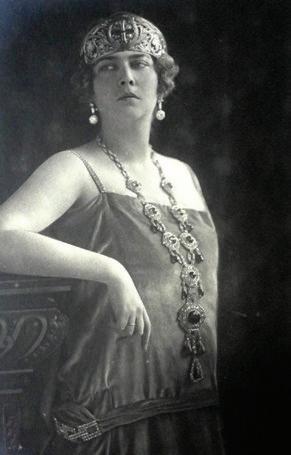
Estimate £100,000–150,000
Below:
A pair of fine Chinese Imperial spinach-green jade ‘dragon’ seals, 18th/19th century
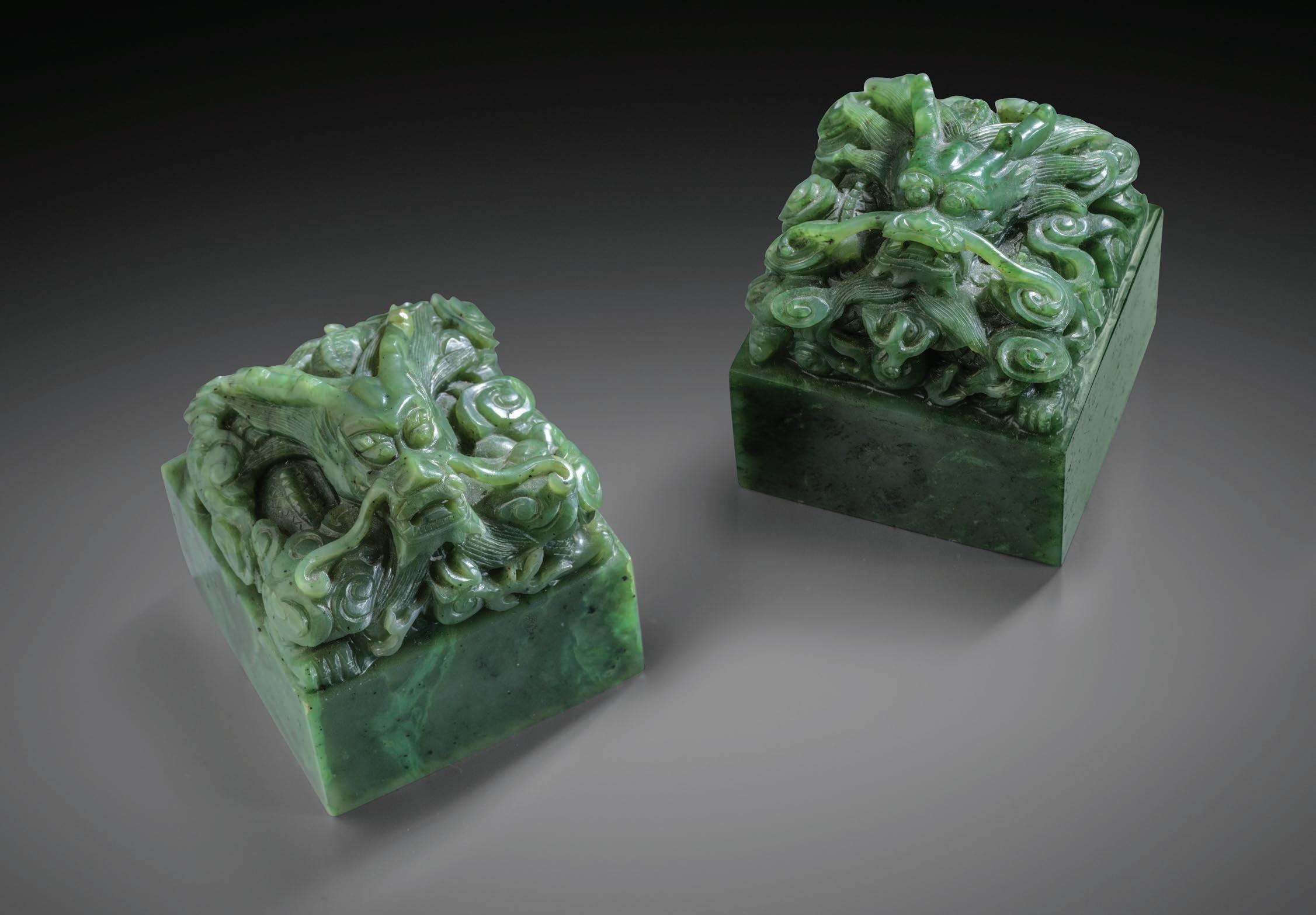
Seals played an important role in Chinese Imperial life. The famous story goes that when the First Emperor Qin Shi Huangdi united China, he made a jade seal with the inscription: ‘Having received the mandate from Heaven, may the Emperor enjoy a long life and eternal prosperity.’ The present two seals were probably made during the Qianlong reign or slightly later.
Provenance: formerly the collection of Major-General Charles Gordon (1833–85)
Estimate £100,000–200,000
FIELD MARSHAL HORATIO HERBERT KITCHENER, 1ST EARL KITCHENER (1850–1916)

Lord Kitchener needs little introduction as a soldier, but is far less well-known as a collector. Famous from the iconic conscription posters, which today make his face synonymous with the First World War, few people are aware of his history as a connoisseur of art and objects.
The vast majority of Lord Kitchener’s collection was auctioned in 1938, but a number of items were passed down through the family including several superb pieces which we will be offering in November.
Above left:
Lord Kitchener (1850–1916)
Above right:
A large Chinese Imperial purple-glazed anhua ‘five dragon’ dish Kangxi mark and of the period 1662–1722, 25cm

Estimate £10,000–20,000
Right:
A rare Chinese blue and white cylindrical Ming-style ‘pomegranates’ vase Yongzheng mark and of the period 1723–35, 25cm
Estimate £15,000–25,000
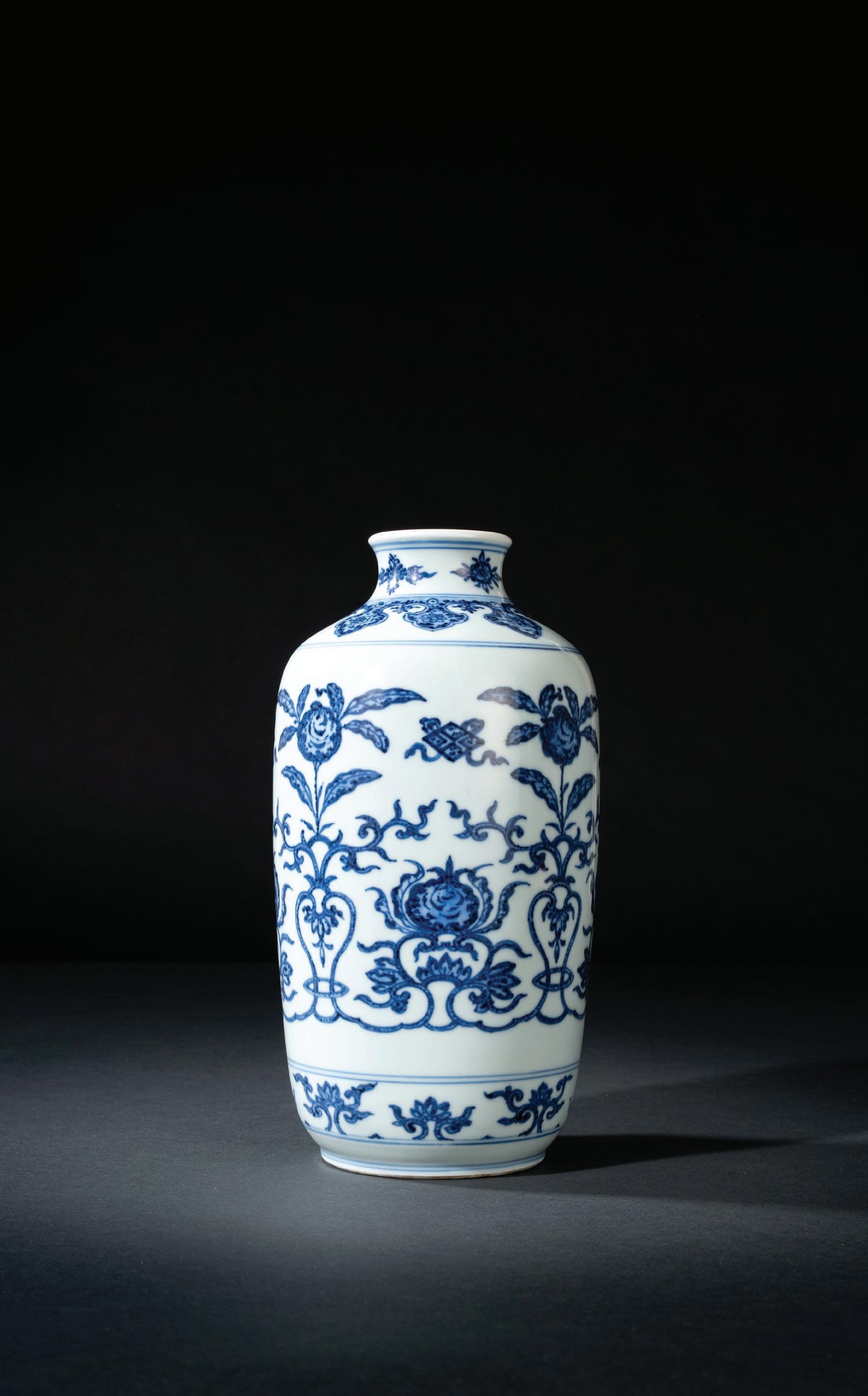
Above:
The receipt for the vase dated 1917
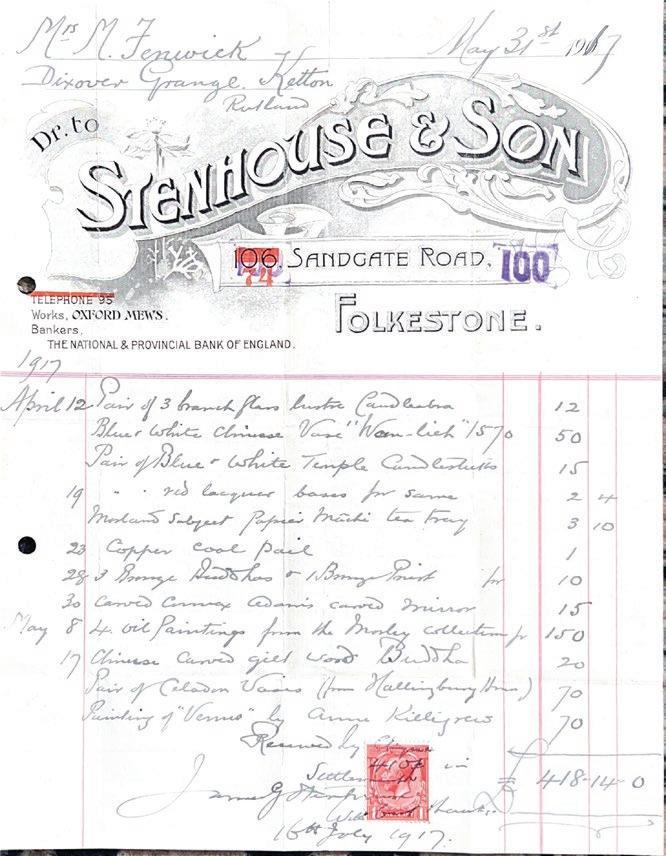
The Fenwick Phoenix Vase
Millicent Fenwick (1864–1942) was born in London to Lord Robert Montagu and Elizabeth Wade. Lord Montagu inherited the Dukedom of Manchester in 1843. His marriage to Elizabeth Wade, a housemaid, scandalised London society.
During the Song and Yuan dynasties meiping were used as wine containers, whereas in the Qing dynasty they were used primarily as flower vases or for display. In the Ming dynasty they were also used as ritual vessels and were placed in the tombs of Emperors, princes, aristocrats and high-ranking generals. Eight blue and white meiping of this form were discovered in the Wanli Emperor’s tomb.
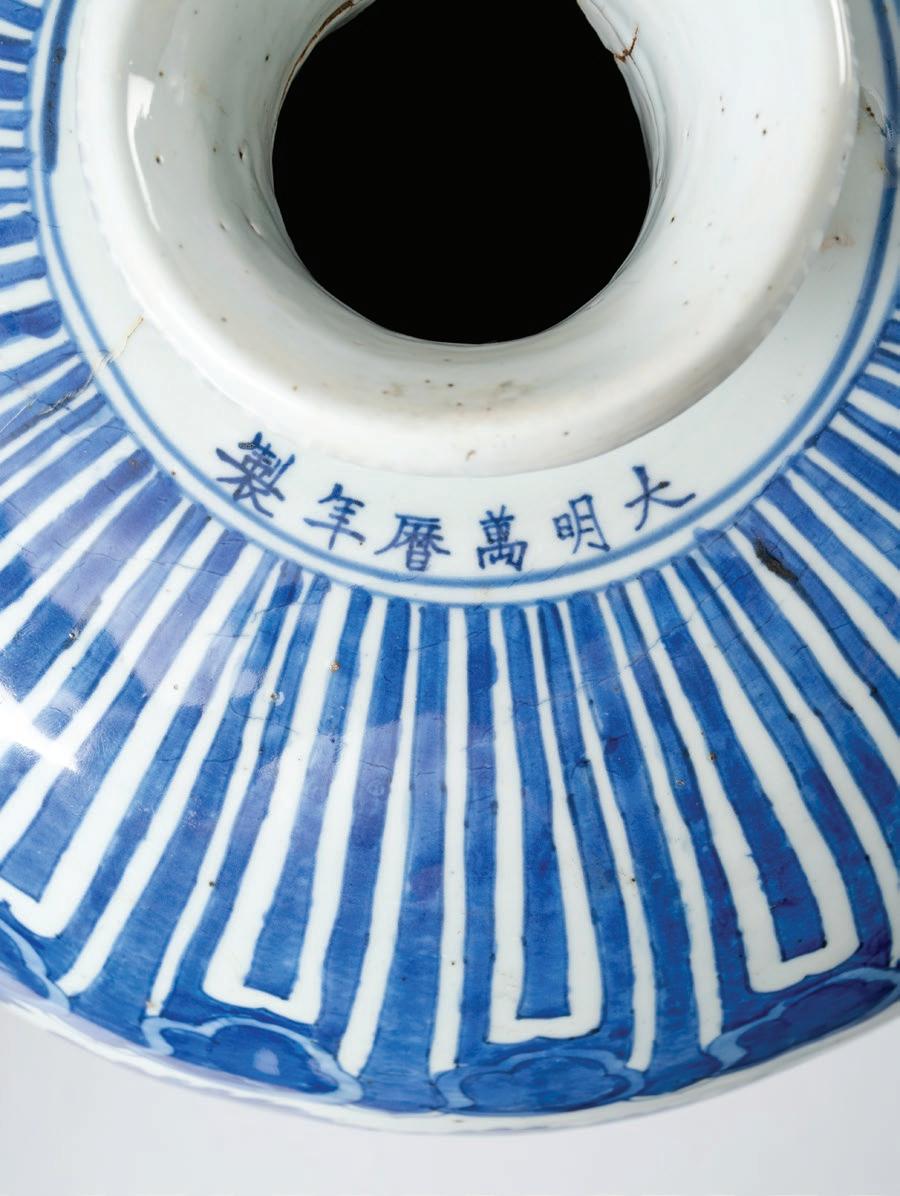
Below:
A massive Chinese Imperial blue and white ‘double-phoenix’ vase, meiping

Wanli six-character mark and of the period 1573–1620
Provenance: from the collection of Mrs Millicent Fenwick, purchased from Stenhouse & Son, Folkestone, 31st May 1917. The family archives include letters between the antiques dealer Stenhouse and Millicent Fenwick, where her purchases are discussed, and which include a note dated May 1917, where Stenhouse states ‘originally purchased by me from the late Mr Larkin’. Estimate £180,000–220,000
The Phillip Allen Collection
Phillip Allen was a much-loved orientalist. He was a council member of the Oriental Ceramic Society, scholarly, generous and fun. I last saw Phillip when he organised an OCS viewing of the Sir Victor Sassoon collection of Chinese ivories, which he catalogued and was instrumental in organising their bequest to the British Museum.

We are very fortunate to have been asked by Phillip’s executors to sell his extensive collection of Chinese and Japanese works of art. The sale comprises over 300 lots, and will have a dedicated printed catalogue.

John Axford
Top: Phillip Allen (1938–2022)
Below:
Norman Blount And Abanindranath Tagore
We are excited to be offering rarities from the collection of Norman Blount (1875–1930). Blount was a jute broker and the joint Secretary of the Indian Society of Oriental Art, which was founded in 1907 in Calcutta, with Lord Kitchener as its President. Blount formed a close friendship with his fellow Society Secretary, the famous artist Abanindranath Tagore (1871–1951). Tagore created a new style of painting, modernising Moghul and Rajput traditions and rejecting Western aesthetics taught in art schools under the British Raj. Tagore’s Bengal School of Art was highly regarded, and was eventually adopted as the national Indian style. The sale will include a number of paintings gifted to Blount by Tagore, and most notably, A Midnight Music Party (illustrated here). Official copies of the picture were commissioned by the Indian Society of Oriental Art, signed by the artist, and stating that the original was owned by N. Blount. One is in the Victoria & Albert Museum, London.
The sale will also feature a selection of important Chinese and Himalayan works of art from Blount’s collection.

Left top:
A rare Tibetan Mandala depicting green Tara and Amoghasiddhi in yab yum, 17th century Tibet, Ngor monastery. To the reverse is the incantation ‘Om Ah Hum’ written towards the centre in Tibetan many times 50 x 37cm

Estimate £8,000–12,000
Left:
Abanindranath Tagore (1871–1951)
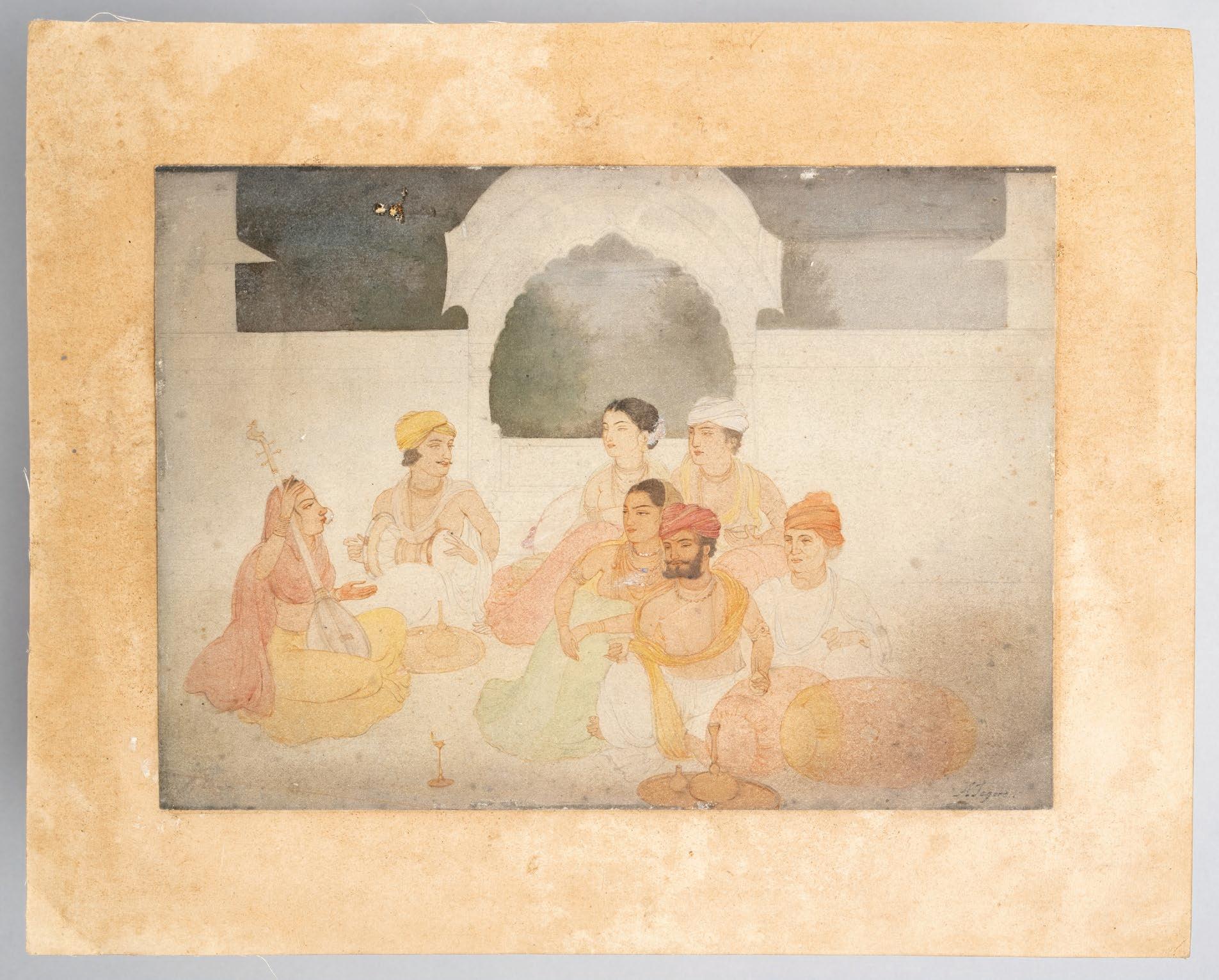
A Midnight Music Party, watercolour on paper, 17 x 23.5cm
Estimate £5,000–8,000










